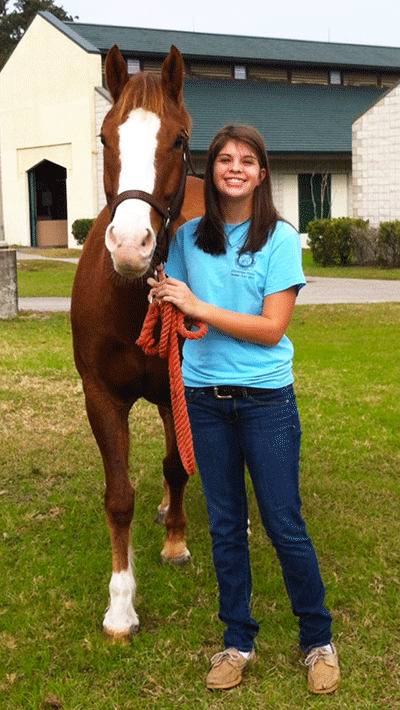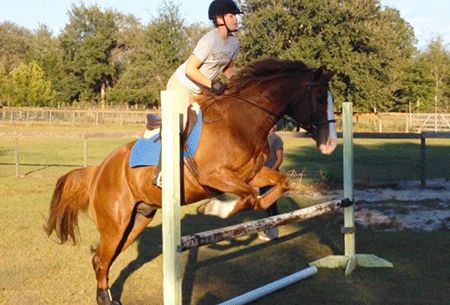
On a Friday afternoon in January 2013, a barn manager found Sonny, an appendix quarter horse owned by Amy Barton, with an injury to his left hind fetlock.
The injury looked bad, so Barton called her primary care veterinarian, Dr. Jennifer Frank, who asked Barton to send her a photo of the injury. Dr. Frank saw the photo and recommended that Barton take Sonny to the UF Large Animal Hospital in Gainesville.
“Dr. Frank told us that the injury may be in the joint so it needed to be examined immediately,” Barton said. “We were worried he wouldn’t be able to stand in the trailer, but thankfully it was only 20 minutes away and we made it there.”
Due to the location and type of injury, Sonny was admitted to the Large Animal Surgery service, where Dr. Alison Morton and Dr. Andrew Smith were on duty and took the case. Sonny stoically walked into the hospital sound, but his entire fetlock was swollen and painful to the touch. The surgeons examined him immediately and noted that when pressure was applied to the joint capsule, fluid could be seen exiting the wound that told the veterinarians the joint was involved in Sonny’s injury.
“We were sure the joint was involved, we just weren’t sure to what extent the joint was contaminated or damaged,” Dr. Smith said. “We recommended an arthroscopic surgery in order to get a good look at the inside of the joint to assess the total extent of damage and contamination, and to clean-up any contamination and treat any damage.”
Arthroscopy is both a diagnostic and surgical procedure that allows veterinarians to view the interior of a joint. A small incision into the joint capsule is made through which a small camera is inserted, allowing veterinarians to identify and treat abnormalities. The procedure is especially beneficial to horses because it does not require the joint to be completely opened up, leading to less discomfort, faster healing and usually a better outcome.
Barton was nervous about the procedure, but Dr. Smith was confident that arthroscopy was Sonny’s best option. Barton agreed to move forward with the surgery.
“I knew they were capable and could treat for infection, but my biggest fear was managing infection,” Barton said. “If the bacteria was resistant to an infection, Sonny might never get back to work at the same capacity. However, I was optimistic that Sonny would make it to that point.”
As treating the joint early and aggressively gave Sonny the best chance at a return to soundness, the horse was taken straight to surgery that evening. “Once we got into surgery, we found that the contamination was worse than we originally thought,” Dr. Smith said. “The surgery took a little longer, as we removed a fair amount of hair and debris from the joint and then debrided the original wound while we flushed the joint. At the end of the procedure, we injected an antibiotic into the joint and covered it with antibiotic-impregnated gel foam. Finally, we applied a sterile bandage and Sonny recovered from anesthesia without problems.”

Post-operatively, Sonny was given antibiotics, both intravenously and locally to the joint, as well as anti-inflammatory medications. He gradually became more mobile throughout the weekend. By Monday, Sonny’s wound was debrided a second time and then sutured closed in order to prevent further contamination and optimize healing. Sonny was walking well, had a great appetite and all of his vitals were within normal limits. The veterinarians discontinued his intravenous medications seven days after the surgery and Sonny was able to go home.
Dr. Frank came for a follow-up visit a week later and to have Sonny’s sutures removed, and Sonny continued to improve. A few months later, Sonny was back to work, competing in dressage, show jumping and cross-country eventing through the pony club with Barton’s daughter, Katie.
“It was really nice how accessible and nice the hospital staff was after they sent Sonny home,” Barton said. “After the healing period, he’s as good as he was 15 minutes before the accident. Dr. Smith said he would be, and he is.”
View all UF Large Animal Hospital Success Stories.




